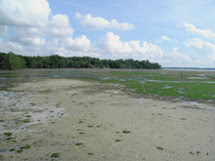a. (i) Name the instrument shown in Fig. 3.
Stevenson screen
(ii) Explain why this instrument has louvres on its side and why it is always set above ground.
The louvres are there to allow air to pass through.
It is set above the ground so that it would not be affected by heat from the ground.
These features help to ensure that the readings from the six's thermometer in the box are as accurate as possible.
b. (i) Where is the best place to put a rain gauge?
D
(ii) Give two reasons for your choice on why it is the best location.
D is an open area and grass is a poor conductor of heat; this ensures that the rain gauge would not be overheated and cause evaporation of rainfall collected
(iii) Explain why the other locations are not ideal.
A is located near an obstruction, in this case a building
B is located near obstructions such as trees and a building
C is located close to trees, also an obstruction.
All these would affect the amount of rain collected.
c. Define the term 'temperature' and state two factors that will affect it.
Temperature is the degree of hotness and coldness of the air. Altitude, latitude and time of day affect temperature. (pg. 142)
Subscribe to:
Post Comments (Atom)


No comments:
Post a Comment